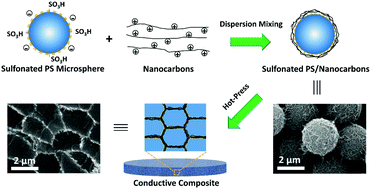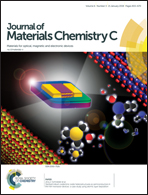Facile fabrication of highly conductive polystyrene/nanocarbon composites with robust interconnected network via electrostatic attraction strategy†
Abstract
An electrostatic attraction strategy was employed for the preparation of highly conductive composites using commercialized graphene or multi-walled carbon nanotubes (MWCNTs) as conductive fillers and polystyrene (PS) microspheres as the resin matrix. The PS microspheres were first sulfonated to endow them with a highly negatively charged surface while the nanocarbons were positively charged in water using an amino-functionalized perylene bisimide as a stabilizer. Direct mixing of the sulfonated PS microsphere and the aqueous nanocarbon dispersion produced agglomerates with PS–nanocarbon core–shell structure due to electrostatic attraction interaction. An interconnected conductive network was formed after hot-pressing the agglomerates. Because of the strong electrostatic attraction and the high Tg temperature of the sulfonated layer, the interconnected conductive network was well-preserved even at a low filler content or a high hot-pressing temperature, resulting in an ultralow percolation threshold of the composites (<0.047 vol%) and conductivity up to 104 S m−1 at a graphene content of 4.51 vol%, and to 391 S m−1 at a MWCNTs content of 3.20 vol%. The above approach is time-saving and applicable to the manufacture of other conductive polymer-based composites.



 Please wait while we load your content...
Please wait while we load your content...